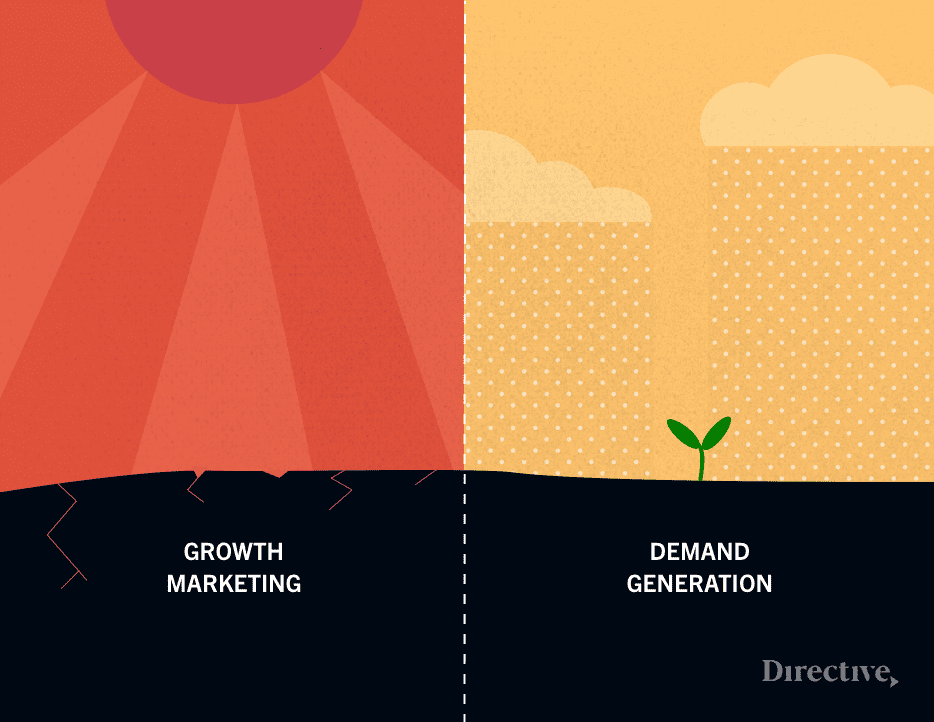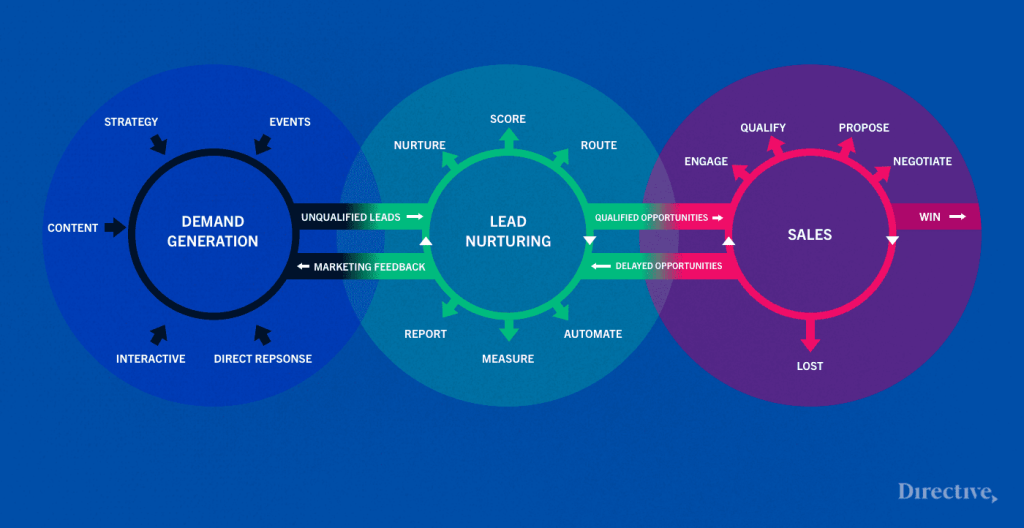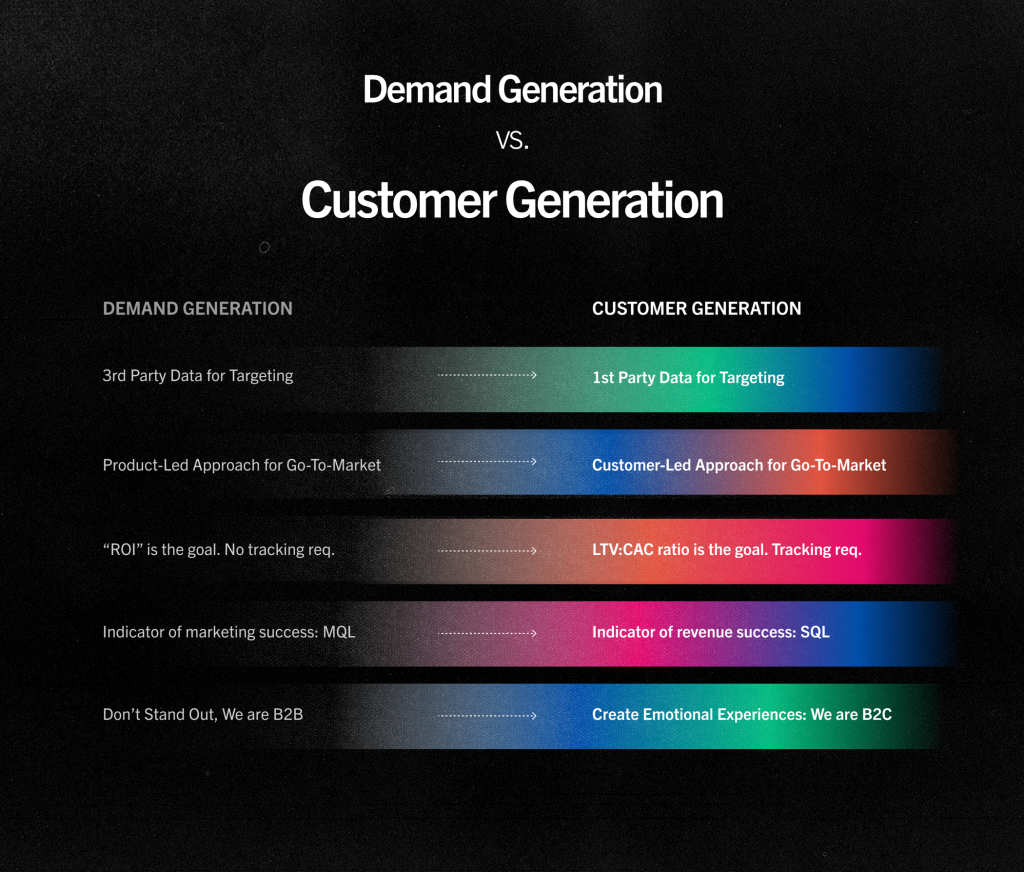When it comes to getting the most bang for your buck, knowing which SaaS demand generation strategy to bet on can be a huge deciding factor.
Of course, in the complex B2B buyer’s cycle of the modern day SaaS market, knowing what exactly constitutes” demand” can be tough to pin down.
We know that we want to generate demand (or interest/need) for our software or software service. But with the extended lifecycle and consideration phase of the average end-buyer in SaaS, how can we track interest? What marketing touch-points qualify as generating demand while others simply boost vanity metrics?
In this post we’ll be walking through what exactly is included under the Demand Gen umbrella – as well as how to see if your SaaS demand generation strategies are actually driving revenue or simply blinding you with empty performance.
What Is Demand Generation?
Especially in a highly technical and equally saturated market like SaaS, not everyone knows what you’re selling. With the countless different software solutions being offered today – each for unique solutions to specific pain points – you need to make sure that your audience is aware of their need for your brand.
This is where Demand Generation strategies drive their value – creating the awareness, visibility, and need for your SaaS brand.

Simply put: Demand Generation is the focus of targeted marketing programs to drive awareness and interest in a company’s products and/or services.
History of Demand Generation
Demand Generation strategies were originally developed to help focus their more aimless predecessor: Growth Marketing. While the explosion of digital marketing in the post-digital marketing world opened up countless new Growth Marketing channels, it made attribution a nightmare.
Demand Generation as a practice was meant to help be a guiding light to originally aimless Growth Marketing strategies.

However, where Demand Gen managed to isolate certain marketing touchpoints as correlative to growth, it failed to complete the connection.
As opposed to more traditional buying cycles like the eCommerce example above, the [SaaS] buyer’s journey is a bit more complex […] With all the different touch points in the vastly complex buyer’s journey of a given SaaS campaign, there’s no wonder things can get a little muddled. [T]his is where most demand gen strategies fall short.
– Sean Martin | Directive, Marketing Manager
Now, because we mentioned demand generation’s limitations you’re probably already thinking “Well what about Lead Generation?”
Well, true, there is also the other side of the coin to consider. According to Sendoso: While demand generation and lead generation would seem interchangeable, demand generation focuses on brand awareness and product education at the top of the funnel, where lead generation is focused on converting prospects into qualified leads that can be nurtured into becoming customers.
While this is true, it doesn’t quite tell the whole story. I like to add a little bit of elaboration to paint a more complete picture of the lead-gen vs demand-gen debate:
Imagine flipping a coin for the success of your growing SaaS brand.
Heads: You manage to widen your brand’s visibility and awareness for the need for your product, but struggle to actually drive leads and revenue. Tails: You have no problem driving leads, but can’t seem to scale your exposure. Sounds like a frustrating situation, doesn’t it? Welcome to the world of Demand Generation and Lead Generation.
What Is SaaS Demand Generation Strategy?
So what exactly is the difference between SaaS demand gen and SaaS Demand Generation Strategy? Well if the word didn’t give it away the first time, it’s the strategy.
Modern-day SaaS marketing strategies need a higher level, prioritized, and financially backed modeling system on which to build their go-to-market strategies.
A truly successful SaaS demand generation strategy is more than just a timeline and a content calendar with some conversion goals set each month. LTV:CAC aligned goal setting, offline conversion tracking, and incremental inputs that can be controlled is how you can a domination strategy.
The better you can understand your target market and the resources necessary to truly move them from apathy to action, the better you can avoid the classic Demand Gen cliff that so many SaaS marketers runoff.

Demand Generation Strategy 101: What Works VS What Doesn’t?
If you’re working on generating awareness and interest in your product or service, you’re looking at Growth Marketing. However, if you’re working to capitalize off this newly generated demand, now we’re in the realm of SaaS Demand Generation strategies. Demand Generation doesn’t just want to build awareness – it wants to move your customers from apathy to awareness, and ultimately to action.

We could write a hundred different posts on opinions on what types of demand generation strategies work and which don’t (and we may one day still). But the inevitable question we’ll always end up finding ourselves is whether or not the generated significant growth for the brand. Now, how exactly do you measure this growth? Well, with LTV:CAC of course.
LTV:CAC gives you an accurate picture of what is generating actual value (in terms of revenue) and what is actually just burning budget within your marketing campaigns. It is truly the holy grail of SaaS marketing metrics – far beyond just demand generation strategies.

In fact, the foremost reason that most demand generation strategies fall short is because they end up prioritizing MQLs and wasteful growth marketing metrics instead of prioritizing qualified and scalable metrics like SQLs.
Winning Leads With An Effective Demand Generation Strategy
In fact, both lead generation and demand generation strategies tend to fall victim to this metric misalignment. And when you end up flipping a coin over exposure or engagement, over engagement over activation, or some other impossible choice, what are you left to do?
How do you choose the best side of the coin in this situation?In a 50:50 flip where you really end up crossing your fingers that the MQLs you generate turn into revenue anyway, how do you choose the best finger-crosser?
Winning leads with an effective demand generation strategy comes down to knowing who your total addressable market is and how to best engage them in a qualified and activating manner. How can you provide the most value to the most targeted description of your end-buyer? That’s the question your SaaS demand generation strategies need to answer.
How To Craft and Implement A Demand Generation Strategy
Now we’ve already covered the bulk of what a common demand generation strategy focus on. But what about the stand outs? You know, what about the strategies that we wish we thought of ourselves? The ones that are truly considered remarkable and can back up that memorable brand experience with serious revenue generated from it.
Well, luckily, here at Directive we prioritize R&D and first party data in order to back each of our own strategic suggestions with a proof-is-in-the-pudding mentality. Through our own intensive studies and testing we’ve been able to identify 5 core principles of highly effective SaaS demand generation strategies:
1st Party Data Unlocks Scale
Mapping your Total Addressable Market (TAM), building account lists, and aggressively scaling spend using 1st party data not only future proofs your campaigns; but also gives you the confidence to grow brand advertising because every impression delivered will be a future customer.
Customer-Led & Product-Led
Your product is not for the masses. Customer-Led SaaS marketing strategies give you the power to impact business KPIs such as: average contract value, trial conversion rate, lifetime value, customer acquisition cost, and more. By focusing on your most valuable customers, you truly are in control.
Financial Modeling is a Need to Have
Scale without financial modeling is a pipe dream. Make sure you identify your most impactful levers through a customer-led lifecycle marketing agency while acquiring the tools needed to improve your capital allocation.
SQLs Beat MQLs Every Time
MQLs are like balloons. When they inevitably pop, there’s nothing inside. Great marketing makes you money. Let’s keep this one simple.
There’s No Such Thing as B2B
Your customers are people, not corporations. They hate inhumane marketing as much as you do, we promise. Let’s change the expectation of what B2B search marketing is together.
The Inherit Downfalls Of Demand Generation Strategies
The issue with most attempted demand gen and lead gen combinations is misaligned goals and metrics. Simple as that.
Because each strategy operates on different NSMs that aren’t tied back to the same singular goal, there’s no way the hand-off between demand gen and lead gen and alignment with sales can be a clean one.
No wonder these old school methods lead to so much waste compared to more customer-aligned approaches. If you want to move beyond aimless efficiency, you can’t just optimize everyone for their individual performance. You need to make sure everyone is looking at the same goal as well.
Remember that MQL cliff graphic that we went over earlier? Getting déjà vu yet, anyone?
How To Concoct an Effective SaaS Customer Generation Strategy
It’s time we all start focusing less on vanity metrics and more on what matters – generating customers. This is why Directive has crafted our very own customer-led marketing methodology: Customer Generation.
If you’re interested in learning more about Directive’s new marketing methodology and want to learn more about this new customer-led philosophy, be sure to join Society – the first exclusive #Slack Community dedicated to SaaS Marketing (now over 1300+ members!).
1,300+ Member SaaS Community
